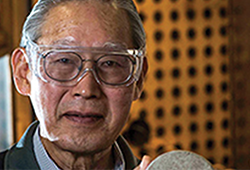
George Hirasaki's graduate lab is studying new engineering methods from every possible angle.
For many engineers, the Navier-Stokes equation is commonly used to model things like weather patterns, aircraft design and the ocean's tides. In 1963, though, this equation took on a new form as George Hirasaki reimagined it to model blood pumping through an artificial heart. "At the time, no one had been able to solve the Navier-Stokes equation in three dimensions," Hirasaki said, "but that's what we had to do."
As a Ph.D. student, Hirasaki was part of the Rice-Baylor Artificial Heart Program, led by J.D. Hellums, W.W. Akers and Michael DeBakey, that worked to revolutionize cardiovascular science. The experience left an indelible mark on the young researcher, and throughout Hirasaki's half-century career as a Shell Oil researcher and Rice professor, he has sought to create similar opportunities for discovery, knowledge and achievement for his peers and students.
In Hirasaki's lab, graduate students are currently studying the flow of fluids through porous media, including how to safely and more effectively extract oil and gas from stone. As alternative methods for crude oil exploration continue to increase globally, Hirasaki and his students will play a greater role in developing more sustainable methods of fluid extraction. In addition to formulating new theories, Hirasaki's students are also expected to help build the customized equipment that they need to prove their processes. Using foam, magnets and other innovative techniques, they tackle engineering problems with creative new approaches.
"When these students start their careers, they will be supervising technicians and managing teams of engineers," Hirasaki says. "They will make better leaders if they know what it takes to complete every task in the lab. That's how they become experts in the process."
To help Rice graduate students discover new techniques in modern engineering, Hirasaki and his wife, Darlene, have included the Department of Chemical and Biomolecular Engineering in their planned gift to Rice. "It's important for them to look to the future," Hirasaki says about the changing oil and gas industry. "This is where the next twenty and more years of the industry are, and Rice students will be a part of them."
Hirasaki's steadfast commitment as both a mentor and a donor is providing engineering students with the opportunity to live their dreams. His legacy of creative theory, computation, experimentation and visionary research challenges students to think about the impact their discoveries will have. Just like Hirasaki's own Ph.D. research helped to change the world of cardiology, his graduate students and fellows will forge new paths in the world of petroleum engineering.
If you would like to support the Department of Chemical and Biomolecular Engineering - or the work of another innovative department at Rice - please contact our gift planning team at [email protected].